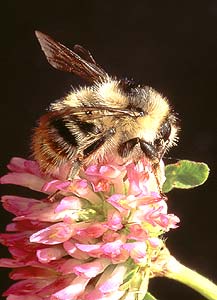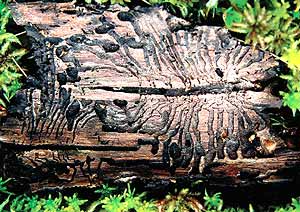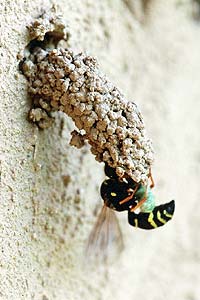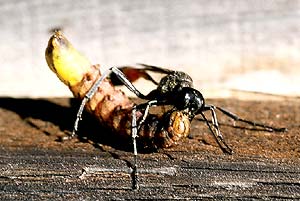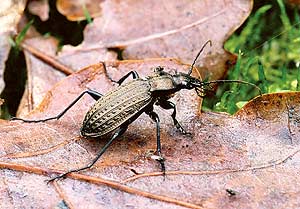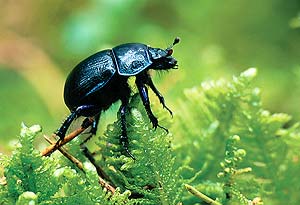|
TERRESTRIAL INSECTS
|
|||||||||||||||
Text:
|
The importance of insects
Insects represent animals commonly found in different types of the environment. They adapted to extremely harsh living conditions by developing modified, and often quite complicated mouth-parts. This helps them use all kinds of available food. It is therefore not surprising, that these widespread and numerous animals significantly affect the environment in which they live. Insects are also of great importance for the economy. Some of them are our allies whereas others are grimly fought enemies.
One of the most important roles insects play in the natural word is the pollination of flower plants. Over millions of years, the evolution of flower plants and the related insects proceeded in parallel. As a result, various tools for collecting and transporting pollen have been developed, such as ventral brushes, pollen-baskets on legs or tufts of hair on other parts of the body. Some species, for instance, have unusually long tongues which help them reach the bottom of elongated flower tubes in search of nectar. Some insects pollinate flowers blooming in the daytime while others prefer flowers that open at twilight. The most important pollinators of flower plants are hymenopterans, especially wild bees, as well as lepidopterans, dipterans and coleopterans.
Numerous insect species compete for food with man, causing considerable damage to crops or consuming wild plants which are also utilized by people. The chrysomelid beetles (Chrysomelidae) feed on green plant tissue. This leads to a significant decrease in the size of yield where the beetles occur in large numbers.The most famous representative of this family is the Colorado beetle (Leptinotarsa decemlineata). Other species commonly found in the Park include the red poplar leaf-beetle (Chrysomela populi), which feeds on poplars, willows and aspen, as well as one of the spotted leaf beetles, Chrysomela viginitipunctata.
Insects which exercise the greatest influence on tree stands are the bark beetles (Ipidae). These miniature beetles can cause the withering of large forest areas already weakened by air pollution or severe weather conditions such as long-lasting drought. Bark beetles live mainly in wood and under the bark, the traces of boring of which are characteristic of individual species. Most changes in the spruce stands of the Wigry National Park have for years been caused by the eight-dentated bark beetle (Ips typographus).
Tree stands are destroyed also by some Hymenoptera species. The mass occurrence of phytophagus hymenopterans (Symphyta) such as the pine web-spinning sawfly (Acantholyda posticalis) or the pine sawfly (Diprion pini), can severely damage the assimilation organs in trees (caterpillars feed on needles) and significantly decrease their immunity to possible attacks of other insects (e.g. one of buprestid beetles, Phaenops cyanes) or fungi, presenting as they do a considerable danger to entire tree stands.
A small group of insects feeds on the blood of warm-blooded animals. This way of acquiring food is characteristic of certain dipterans such as keds ( Melophagus), fowl flies (Ornithomyia), horse flies (Tabanus) and deer flies (Chrysopus), as well as various bugs (e.g. bed bug). Blood-sucking dipterans may transmit many diseases. Horse flies and deer flies may carry rabbit fever and plague germs by sucking the blood of farm animals.
In spite of their arduousness as well as negative impact on the environment of man, insects play an important role in the natural world. Many species of predatory and parasitic insects significantly reduce the number of organisms which are harmful to the human economy. These insects regulate and maintain the biocoenotic balance and ensure in this way a proper functioning of the natural environment. This insect group includes, among others, all carabid species (Carabus). The larvae of most ladybird species (Coccinellidae) (e.g. two-spot lady-bird) play a similar role in nature by devouring enormous amounts of aphids, scale insects and other tiny insects. Some species of the rove beetles family (Staphylinidae) penetrate the corridors of bark beetles in search of their larvae. A similar behaviour is typical of some representatives of the chequered beetle family (Cleridae), including the ant beetle (Thanasismus formicarius) inhabiting the park.
Another group of insects which plays a crucial role in different types of forest environment is ants (Formicidae). Large mound ants belonging to the Formica genus act as „orderlies” by regulating the number of other insects. In the case of the mass appearance of Lepidoptera or Diptera caterpillars feeding on plants, ants switch to these species thereby significantly reducing their number. By building their nests, ants improve the quality of the soil. Numerous chambers and corridors in the underground part of the nest have a beneficial impact on the air and water regime in the soil.
Insects actively accelerate the circulation of the organic matter in the environment. The larvae of many Diptera species (e.g. bluebottle flies Caliphora and flesh-flies Sarcophaga) feed on dead plants and animals as well as on animal dung. This significant contribution leads to a faster decomposition. Carrion is a source of nourishment for numerous beetle species (e.g. burying beetles (Necrophorus) and carrion beetles Silpha). Because eggs are deposited in the carrion, the larvae feed on the animal remains. The dor beetles (Geotrupes) remove immense quantities of dung from the environment. They build deep burrows ending with chambers under an accumulation of dung where females deposit their eggs. The beetles then fill the chambers with lumps of dung providing food reserves for the developing larvae.
|
||||||||||||||
|
|
|
